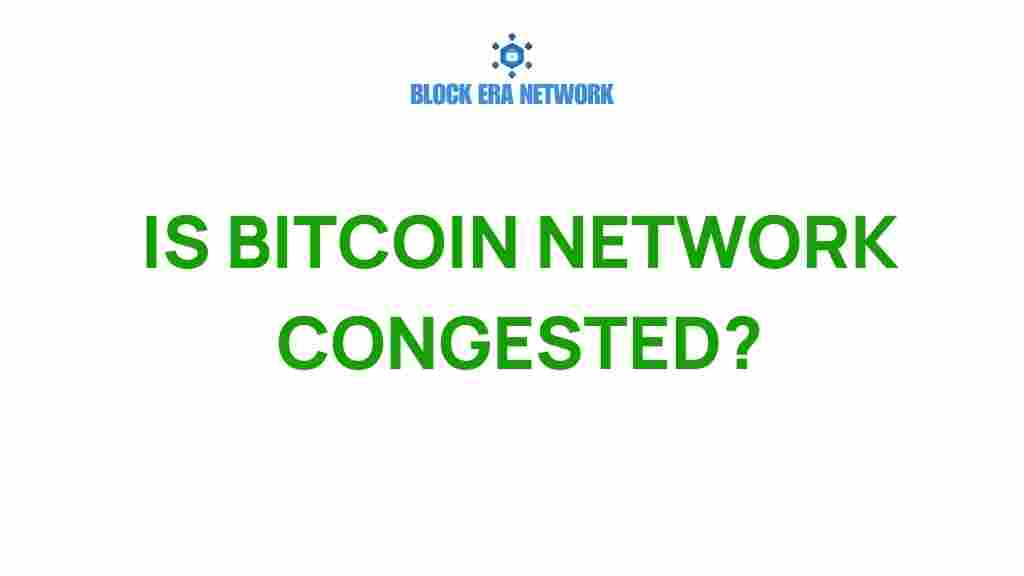Is the Bitcoin Network Facing Congestion? Here’s What You Need to Know
As the popularity of Bitcoin continues to rise, many users are left wondering about the operational efficiency of the Bitcoin network. Is it facing congestion? This query has become increasingly relevant as more people engage in cryptocurrency transactions. In this article, we will delve into the concept of network congestion in the Bitcoin blockchain, examining transaction speed, fees, scalability, and how user demand impacts the overall experience.
Understanding Bitcoin and Network Congestion
Bitcoin operates on a decentralized blockchain technology that allows for peer-to-peer transactions without the need for intermediaries. However, as more users join the ecosystem, the potential for network congestion increases. Network congestion occurs when the number of transactions exceeds the capacity of the blockchain to process them efficiently, leading to delays and higher transaction fees.
Key factors contributing to network congestion include:
- User Demand: An increase in the number of transactions can strain the network.
- Transaction Speed: The time taken to confirm a transaction can vary based on network activity.
- Fees: Higher demand often leads to increased fees as users compete for priority in processing.
- Scalability Issues: The inherent limitations of the Bitcoin protocol can hinder its ability to scale effectively.
The Mechanics of Bitcoin Transactions
When a user initiates a Bitcoin transaction, it is broadcasted to the network and included in a pool of unconfirmed transactions known as the mempool. Miners then select transactions from this pool to include in the next block they mine. The selection process is influenced by the transaction fees attached to each transaction, leading users to adjust their fees based on current network conditions.
Transaction Speed and Fees
Transaction speed is an essential aspect of any cryptocurrency, and Bitcoin is no exception. On average, Bitcoin transactions can take anywhere from 10 minutes to several hours to confirm, depending on network congestion. During peak demand periods, users may experience:
- Longer Confirmation Times: Transactions may take longer to be included in a block.
- Higher Fees: Users may need to pay higher fees to ensure their transactions are prioritized by miners.
It is important for users to monitor the current state of the Bitcoin network to understand optimal times for transactions. Tools such as blockchain explorers can provide real-time insights into network congestion and transaction fees.
Scalability: The Heart of the Issue
The scalability of the Bitcoin network has been a topic of intense debate among developers and users alike. The Bitcoin blockchain has a block size limit of 1MB, which restricts the number of transactions that can be processed in each block to approximately 3-7 transactions per second. This limitation becomes even more pronounced during periods of high user demand.
To address scalability issues, several solutions have been proposed:
- Layer 2 Solutions: Technologies like the Lightning Network aim to facilitate faster and cheaper transactions by allowing off-chain transactions.
- Protocol Upgrades: Upgrades such as Segregated Witness (SegWit) have been implemented to optimize space usage within blocks.
- Alternative Blockchains: Some users are exploring other cryptocurrencies with higher transaction speeds and lower fees.
Mining and Its Impact on Network Congestion
Mining is a critical component of the Bitcoin network, as it validates transactions and secures the blockchain. Miners compete to solve complex mathematical problems, and the first to solve the problem gets to add a block to the blockchain and is rewarded with newly minted Bitcoins and transaction fees.
As user demand increases, more miners may enter the fray, leading to greater competition. This can have both positive and negative effects on network congestion:
- Positive: Increased miner participation can lead to faster block times if the network hash rate rises significantly.
- Negative: If too many transactions flood the network, miners may prioritize higher-fee transactions, leaving lower-fee transactions unconfirmed for longer periods.
Troubleshooting Network Congestion Issues
If you find yourself facing issues with Bitcoin network congestion, here are some troubleshooting tips:
- Check Network Status: Use blockchain explorers to assess current transaction speeds and fees.
- Adjust Fees: Consider increasing your transaction fee to expedite confirmation during peak times.
- Use Layer 2 Solutions: Explore options like the Lightning Network for faster transactions.
- Be Patient: During times of high congestion, it may simply take longer for your transaction to be processed.
Future Outlook: Is the Bitcoin Network Sustainable?
The future of the Bitcoin network largely depends on its ability to adapt to increasing user demand and scalability challenges. While the Bitcoin community has made strides in mitigating network congestion through various solutions, ongoing innovation is crucial.
Key developments to watch for include:
- Improvements in Layer 2 Solutions: Enhancements to the Lightning Network and similar technologies may significantly reduce congestion.
- Increased Adoption of SegWit: Wider implementation of SegWit can help optimize transaction processing.
- Potential Protocol Changes: Future updates to the Bitcoin protocol could address scalability more effectively.
Conclusion
In conclusion, while the Bitcoin network is indeed facing congestion challenges due to rising user demand and scalability issues, there are multiple avenues for improvement. As users of this revolutionary cryptocurrency, staying informed about network conditions, transaction speeds, and fees is essential for a seamless experience.
By leveraging available technologies and keeping an eye on future developments, users can mitigate the effects of network congestion and continue to benefit from the advantages of Bitcoin. For more detailed information about Bitcoin and its network, consider visiting reputable cryptocurrency resources that offer insights and updates.
This article is in the category Cryptocurrency Insights and created by Block Era Network Team
